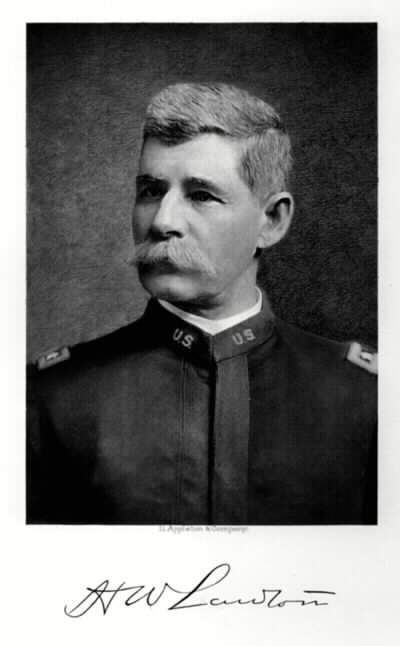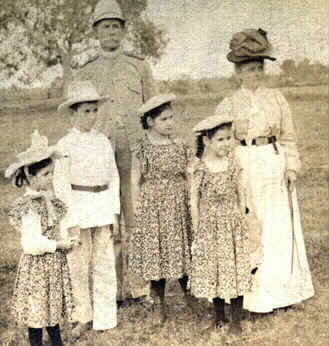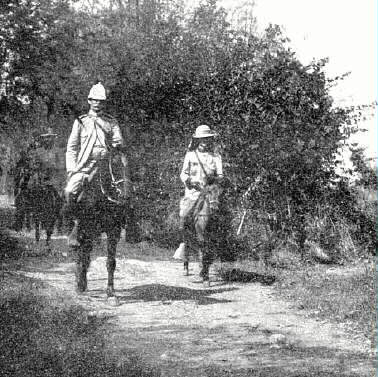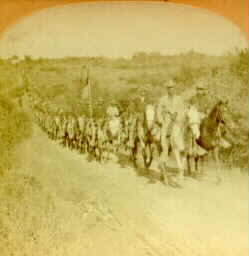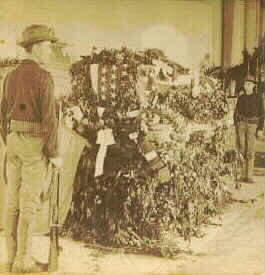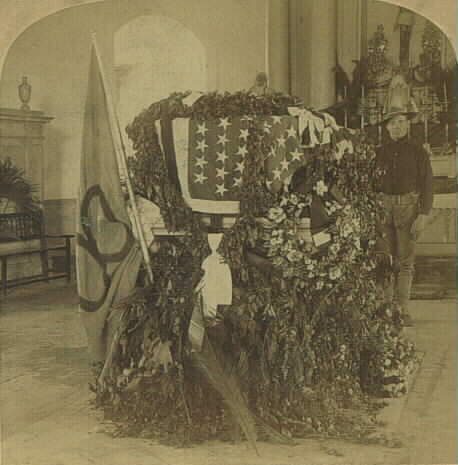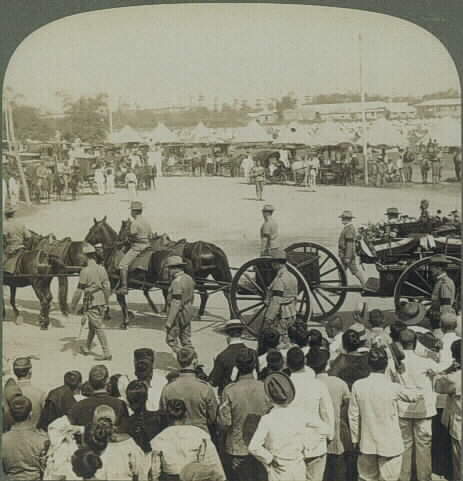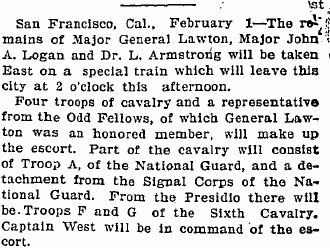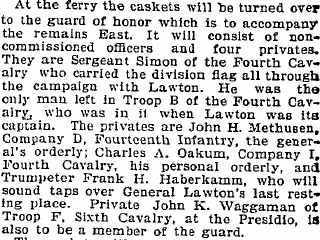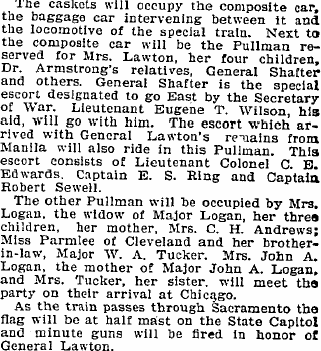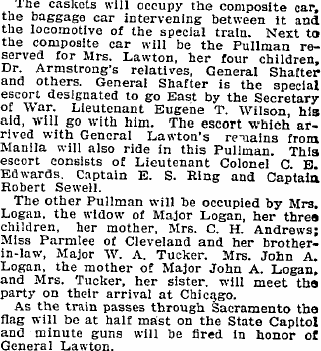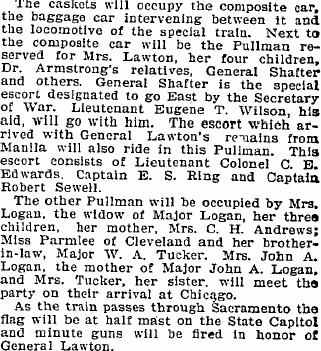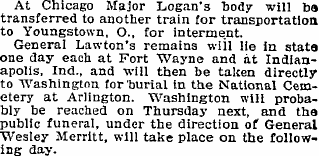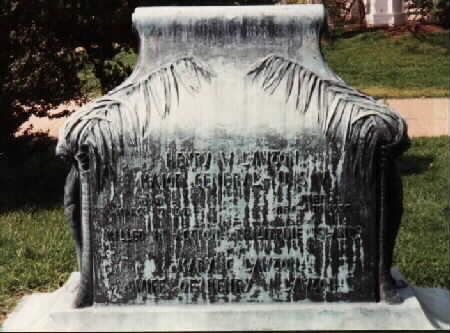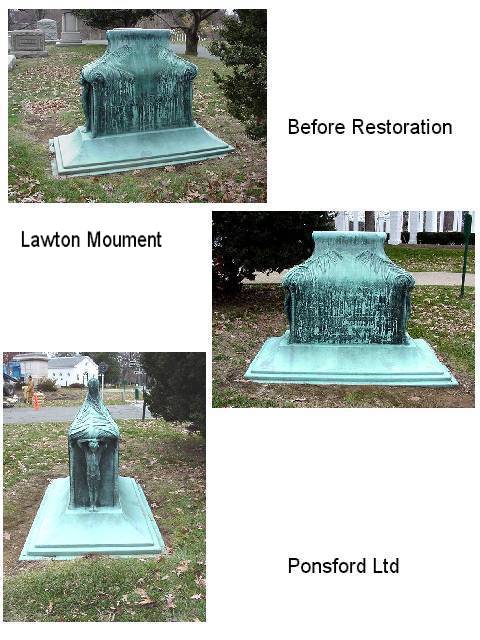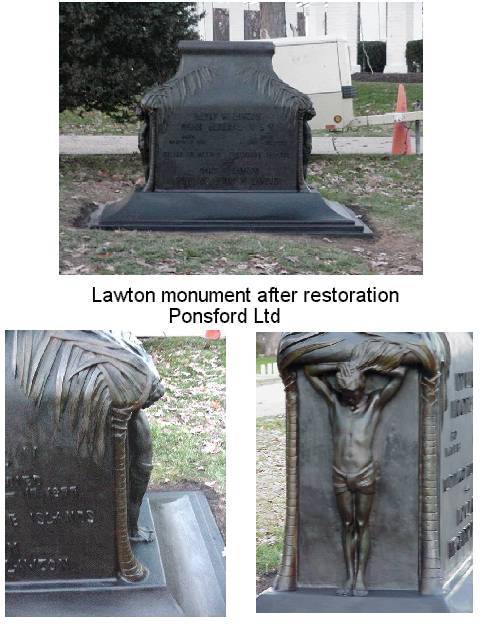Medal of Honor: Civil War. Rank and organization: Captain, Company A, 30th Indiana Infantry. Place and date: At Atlanta, Georgia, 3 August 1864. Entered service at: Ft. Wayne, Allen County, Indiana. Birth: Ohio. Date of issue: 22 May 1893. Citation: Led a charge of skirmishers against the enemy’s rifle pits and stubbornly and successfully resisted two determined attacks of the enemy to retake the works.
Born in Manhattan, Ohio, March 17, 1843, he was brought up in Indiana, and at beginning of Civil War, before he was 18 years old, he entered army as Sergeant in the 9th Indiana Infantry. In August following he was commissioned a First Lieuteant in the 30th Indiana Infantry. In May 1862 he was promoted Captain, in November 1865 to Lieutenant Colonel, and on March 13, 1865 he was brevetted Colonel for especially distinguished services in the field before Atlanta.
He was commissioned Second Lieutenant 41st US Infantry, July 28, 1866, promoted to First Lieutenant, July 31, 1867, transferred to the 24th Infantry, November 11, 1869, transferred to the 4th US Cav, January 1, 1871, promoted to Captain, March 20, 1879, Major and Inspector General, September 17, 1888, and Lieutenant Colonel in the same Department, February 12, 1889.
He greatly distinguished himself in several Indian campaigns in the history of army, crowning his many signal achievements with the capture of Geronimo and his band of hostile Apaches in 1886. After declaration of war against Spain in 1898 he was appointed Brigadier General of Volunteers, March 4, and Major General, July 8 following, and in the regular army was promoted to Colonel and Inspector General, July 7 of that year. In early part of the campaign against Santiago he had charge of the forward movement of US troops and further distinguished himself by the capture of El Caney after a notable engagement with Spaniards, for which he was given two stars.
On January 19, 1899 he was sent to the Philippines and soon after his arrival at Manila began active operations against Filipino insurgents, and met with remarkable success by adopting the tactics he had followed in his campaigns against Indians. On April 10 captured Santa Cruz, a Filipino stronghold. His next engagement was at San Rafael, where a large number of insurgents were hidden on all sides in the jungle. Had it not been for his experience in Indian warfare the US would have suffered a great loss.
On May 15 he captured San Inidro, which at that time was insurgent capital. On June 1 he was given command of the defenses of Manila, and in October began an offensive movement with a view of capturing Aguinaldo, marching along the road between Bacoor and Imus, and so northward. He everywhere drove the enemy before him and captured a number of towns. On October 19 he had reached Arayat and shortly after made his HQ at Cabanatuan, from which place became active in scattering the insurgents through the surrounding country. During November his movements in the pursuit of Aguinaldo were remarkably rapid and surprised veteran soldiers, as military operations were deemed impossible during long rainy season.
On December 1 he was at Tayng and on the 16th left Manila for San Mateo. Here, during an engagement on 19th, he was on the firing line. Being 6 feet 3 inches in height, and attired in full uniform, he was a conspicuous target for insurgent sharpshooters. Hardly had his staff officers warned him of his danger when he suddenly cried, “I am shot,” and fell dead. In the early part of 1900 his remains were brought back to his native country and buried with distinguished official honors. The sympathies of the public were so strong for his widow and children that a movement was started to raise funds to provide for their future, and within a very few weeks about $100,000 was secured.
Soon after his death an extract from private letter was published, in which appeared following sentence: “If I am shot by a Filipino bullet, it might was well be from one of my own men.” The peculiar phrase attracted considerable attention, especially in the early part of the Presidential campaign of 1900. The letter was written in Manila October 6, 1899, to John Barrett, ex-minister to Siam, then in NYC. The following extract from the letter gives the full setting of the mysterious sentence above quoted, and affords another evidence that the continuation of the insurrection was due to direct encouragement from the US. “I agree with you that mistakes have been made here, but I would to God that the whole truth of this whole Philippine situation could be known by every one in America. I wish the people could know it as I know it, and as you know it. I agree that if the real facts in connection with this story, inspiration and conditions of this insurrection and the hostile ruptures, local and eternal, such as the Katipunan revolutionary society and juntas that now encourage the enemy, as well as the actual possibilities of these Philippines and people and their relation to this great East, which you have set forth so ably, could be understood at home in America, we would hear no more political talk of unjust shooting of government into the Filipinos or of unwise threats of hauling down our flag in the Philippines. You are right. Some of us have modified our views since we first came, and it these so-called anti-imperialists of Boston would honestly ascertain the truth on the ground here, and not in distant America, the, whom I dislike to believe to be other than honest men misinformed, would be convinced of the error of their exaggerated statements and conclusions and of the cruel and unfortunate effect on their publications here. It is kind of you to caution me about exposure under fire, but if I am shot by a Filipino bullet, it might as well come from one of my own men. These are strong words, and yet I say them because I know from my own observation, confirmed by stories of captured Filipino prisoners, that the continuance of fighting is chiefly due to reports that are sent out from America and circulated among those ignorant natives by the leaders who know better.”
He is buried in Section 2, Grave, 841, Arlington National Cemetery. His wife Mary C. Lawton lies with him, as does his daughter, Catherine M. Lawton.
MRS. HENRY W. LAWTON
ANNAPOLIS, Maryland – January 5, 1934 – Mrs. Mary Craig Lawton, widow of Major General Henry W. Lawton, U.S.A., who lost his life from wounds received in battle during the Philippine Insurrection, died here this morning after a long illness, at the residence of her daughter, Mrs. Louise L. Bagby.
Mrs. Lawton, who was formerly Miss Mary Craig of Louisville, Kentucky, was 78 years old.
Surviving are a son, Manley Lawton of Washington, and two daughters, Mrs. Frances Lawton Gayhart, wife of Commander Everett L. Gayhart, U.S.N., who also lives in Washington, and Mrs. Bagby, widow of Lieutenant Commander Oliver W. Bagby , U.S.N.
The General’s grandson, Oliver W. Bagby, Jr., Captain, United States Navy, is also buried in Arlington National Cemetery.
LAWTON, HENRY W
MAJOR GEN U S VOLS
VETERAN SERVICE DATES: Unknown
DATE OF DEATH: 12/18/1899
DATE OF INTERMENT: Unknown
BURIED AT: SECTION EAST SITE 841 EH
ARLINGTON NATIONAL CEMETERY
LAWTON, MARY CRAIG W/O HENRY W
DATE OF DEATH: 01/05/1934
DATE OF INTERMENT: 01/08/1934
BURIED AT: SECTION EAST SITE 841
ARLINGTON NATIONAL CEMETERY
WIFE OF H. W. LAWTON MAJ GEN US VOL
LAWTON, CATHERINE M
DATE OF DEATH: 10/03/1921
DATE OF INTERMENT: Unknown
BURIED AT: SECTION EAST SITE 842W
ARLINGTON NATIONAL CEMETERY
DAUGHTER OF H. W. LAWTON MAJ GEN
LAWTON, HENRY W.
Rank and organization: Captain, Company A, 30th Indiana Infantry. Place and date: At Atlanta, Georgia, 3 August 1864. Entered service at: Ft. Wayne, Allen County, Indiana Birth: Ohio. Date of issue: 22 May 1893.
Citation:
Led a charge of skirmishers against the enemy’s rifle pits and stubbornly and successfully resisted 2 determined attacks of the enemy to retake the works.
Courtesy of the Culbertson Mansion
From the St. Louis Republic, December 20, 1899
Reports on the death of General Lawton in the Philippines
LAWTON FALLS IN BATTLE
Killed While Directing
An Assault On San Mateo, Luzon.
MARCHED ALL NIGHT
Made a Successful Attack
On Insurgents Yesterday Morning
THEN HE WAS SHOT.
Died as Cheers of Troops
Announced the Victory.
Manila’ Dec. 19.–Major General Henry W. Lawton has been shot and killed at San Mateo. He was standing in front of his troops, was shot in the breast and died immediately.
General Lawton left here Monday night, having returned from his northern operations Saturday to lead an expedition through Mariquina Valley, which has been an insurgent stronghold throughout the war. The valley has several times been invaded. but never held by the Americans. General Geronimo was supposed to have there the largest organized force north of Manila, and General Otis wished to garrison Mariquina.
The night was one of the worst of the season. A terrific rain had begun and is still continuing.
Accompanied by his staff and Troop I, Fourth Cavalry, General Lawton set out at 9 o’clock in advance of the main force, consisting of the Eleventh Cavalry and one battalion each of the Twentieth and Twenty-seventh Infantry, which started from La Loma at midnight. With a small escort he led the way through an almost pathless country, a distance of fifteen miles over hills and through canebrakes and deep mud, the horses climbing the rocks and sliding down the hills. Before daybreak the command had reached the head of the valley.
San Mateo was attacked at 8 o’clock, and a three hours’ fight ensued. This resulted in but few casualties on the American side, apart from the death of General Lawton, but the attack was difficult because of the natural defenses of the town.
General Lawton was walking along the firing line within 300 yards of a small sharpshooters’ trench, conspicuous in the big white helmet he always wore and a light yellow raincoat. He was also easily distinguishable because of his commanding stature.
The sharpshooters directed several close shots which clipped the grass near by. His staff officer called General Lawton’s attention to the danger he was in, but he only laughed with his usual contempt for bullets.
Suddenly he exclaimed: “I am shot!” clinched his hands in a desperate effort to stand erect, and fell into the arms of a staff officer.
Orderlies rushed across the field for surgeons, who dashed up immediately, but
their efforts were useless. The body was taken to a clump of bushes and laid on a stretcher, the familiar white helmet covering the face of the dead General.
Almost at this moment the cheers of the American troops rushing into San Mateo were mingling with the rifle volleys.
After the fight, six stalwart cavalry men forded the river to the town carrying the litter on their shoulders, the staff preceding with the colors and a cavalry escort following.
The troops filed bareheaded through the building, where the body was laid, and many a tear fell from the eyes of men who had long followed the intrepid Lawton. The entire command was stricken with grief, as though each man had suffered a personal loss.
Owing to the condition of the country, which is impassable so far as vehicles are concerned, the remains could not be brought to Manila today. Mrs. Lawton and the children are living in a Government residence, formerly occupied by a Spanish General.
San Mateo lies between a high mountain behind and a broad, shallow stream in front, with wide sandbars, which the insurgent trenches and the buildings command. The Americans were compelled to ford the river under fire.
It was while they were lying in the rice fields and volleying across preparatory to passing the stream that General Lawton was shot. All except the officers were behind cover. A staff officer was wounded about the same time and one other officer and seven men were wounded.
After three hours’ shooting the Filipinos were dispersed into the mountains. Colonel Lockett took command when General Lawton fell.
HAD JUST BEEN PROMOTED.
Washington, Dec. 19. — The President’s first intimation of the loss of General Lawton was given him by the Associated Press. The dispatch bringing the news was sent to the White House while the Cabinet meeting was in progress and was immediately sent to the Cabinet room, where it was received with expressions of sorrow and regret.
It was learned at the War Department that instructions had been received last night from the President to prepare General Lawton’s commission as a Brigadier General in the regular army, to fill one of the existing vacancies and the Adjutant General’s clerks were at work on the commission when the information of the General’s death was conveyed to the department.
IN THE CIVIL WAR.
General Lawton was born in Toledo, O., and appointed to the army from Indiana. He won his commission in the army by signal gallantry during the war between the States.
General Lawton was known as a good fighter and a soldier of experience and ability. He served in the Union Army throughout the Civil War, having entered the service as Sergeant of Company E, Ninth Indiana Volunteer Infantry, in April. 1861. He was breveted Colonel for gallant and meritorious services during the war.
He entered the regular establishment in July. 1866, as Second Lieutenant of the Forty-first Infantry (negro) and remained with that branch of the army until January, 1871. In September, 1888, he was appointed Inspector General, with the rank of Major.
At the opening of the war with Spain, President McKinley appointed him Brigadier of Volunteers and assigned him to the command of a division of the Fifth Army Corps commanded by General Shafter.
AGAINST THE INDIANS.
A correspondent writing of General Lawton in the war with Geronimo said: Lawton reminds me always of Scott’s Norman Baron, Front de Boeuf. He has better morals, of course, as well as a very pretty taste in red wines and red birds. but he is as big as the giant slain by Richard of the Lion Heart, is as direct in his methods, and in personal or general combat every bit as savage. There is plenty of the primal man in him. What he thinks he says. He has a strong sense of justice, but his temper is terrific, and he is not gentle. He requires of subordinates the utmost endeavor, and gets it. He asks no one to do work that he is not competent and willing to do himself. Naturally a leader, he goes first. and the more difficult or desperate the undertaking the faster he goes. Upon the gray granite slab which covers the bones of a Confederate officer who sleeps on the magnolia-petaled uplands of Louisiana is an inscription:
“He never told his men to go on.’
“That will do for Lawton when he dies.’ “His capacity to go without food, drink or sleep is seemingly unlimited. ‘Macumazahn’ the Lulus called Quartermain — the one who has his eyes open,’ “Macumazahn Lawton will keep them open for a week at a stretch, when necessary, and then walk, talk, eat. drink or fight a dozen men to a standstill. He has lived a life of peril and hardship. His only rule of hygiene is a tub in the morning. He has taken no sort of care of himself. Yet so splendidly was he endowed by nature that there is no perceptible weakening of his forces.”
The name of Lawton came to be dreaded by the Indians. He was to them the typical and dreaded Anglo-Saxon fighter.
TOWERED AMONG THEM.
A correspondent describing Lawton in the Indian war of the seventies said: “He stood on the Government reservation at San Antonio surrounded by the tawny, savage band of Apaches whom he had hunted off their feet. Near him, taciturn but of kindly visage, stood young Chief Naches, almost as tall as he. In a tent close by lay Geronimo, the medicine man, groaning from a surplusage of fresh beef eaten raw. The squat figures of the hereditary enemies of the whites grouped about him came only to his shoulder. He towered among them, stern, powerful, dominant — incarnation of the spirit of the white man.
“Clad in a faded, dirty fatigue jacket, a greasy flannel shirt of gray, trousers so soiled that the stripe down the leg was barely visible, broken boots and a disreputable sombrero that shaded the harsh features, burned almost to blackness, he was every inch a soldier and a man.
“For the tenth time Geronimo’s band had jumped the San Carlos Reservation. As usual, troops were started upon a perilous chase. For days they followed the trail over a country that the Almighty made in wrath. Further and further — into the vast solitudes they toiled. They lived upon animals no wilder than the men they were pursuing and scarcely more wild than they. The horses long since had been left behind. The cavalrymen were on foot, with Lawton at their head, his teeth hard set.
‘We’ll walk them down,” he told his Sergeant, when the mountains were reached. He did walk them down.
“It was General Miles who had selected Lawton for the task of whipping these Apaches. He followed them night and day with a grim persistence that would not be gainsaid. He nullified the power of the tribe for evil and forever broke their formidable resistance. It was this service which called Lawton from the West and landed him in the Inspector General’s office in Washington, with much official prestige, a fair salary and little to do.”
WON AT EL CANEY.
The inaction of Washington life chafed him; and the chance of hostilities with Spain found him eagerly preferring requests for assignment to service. The opportunity was offered him. At Tampa, Lawton was the first man named by Shafter to assist him.
As Brigadier General of Volunteers he was given command of a division, and in that command stormed El Caney. In all of the fighting of that terrific day he was up to the firing line, saying little, but pacing slowly up and down.
He was one of the three commissioners appointed by General Shafter to arrange with Toral the terms of capitulation, and after the fall of Santiago he policed the city. Lawton’s idea of policing a place of the kind was very simple.
“The regulations are so and so,” he would say, “and you have your gun. If anybody violates the regulations use the gun.”
IN THE PHILIPPINES.
General Lawton sailed for the Philippine islands on the transport Grant, January 19, 1899.
His distinguished services in the Philippines are recent history. He received a special message of thanks from President McKinley after his capture of San Isidro. On his arrival at Manila he relieved General Anderson in command of the regular troops. He captured Santa Cruz, at the extreme end of the lake, near Manila, April 10. This place which was a Filipino stronghold, fell into the hands of General Lawton’s expedition after some sharp fighting, which formed one of the most interesting battles of the war. General Lawton and his staff accompanied the troops, sometimes leading charges in Indian-fighting tactics, which eventually resulted in the complete rout of the insurgents.
The General’s next hard fighting took place in his attack on San Rafael, where the American troops were met with a heavy fire from a large number of insurgents, who were concealed in the jungle on all sides. Only the adoption by General Lawton of the tactics followed in Indian fighting the United States, every man for himself, saved the division from great loss. As usual, General Lawton was at the head his line with his staff. After the capture of San Isidro by General Lawton, President McKinley sent him the following dispatch:
“Otis. Manila: Convey to General Law and the gallant men of his command congratulations on the successful operations during the past month, resulting in the capture this morning of San Isidro. “WILLIAM MCKINLEY.”
DEFENSE OF MANILA.
It was announced June 1 that General Lawton had been placed in command of defense of Manila and the troops forming the line around that city. Early in October, General Lawton was engaged in dispersing the insurgents and cutting off the communication maintained by them between Bacoor and Imus, by means of the road between those places. He was successful in clearing the country of Filipinos, and was several times under fire. He then pushed northward. captured a number of towns and drove the insurgents everywhere before him.
General Lawton and General Young arrived at Arayal October 19 with a force of about 3,000 men. He next made his headquarters at Cabanatuan and took an active part in dispersing the insurgent bands in different parts of the country.
About the middle of November the whereabouts of General Lawton and Gene Young, on account of the rapidity of their movements, became almost as mysterious as that of Aguinaldo. General Lawton’s troops suffered considerable hardship in a series of energetic movements. Numbers of the soldiers and even some of the officers were described as marching ahead, half naked, their clothes being torn to shred getting through the jungles; hundreds of them were barefooted, and all of them were living on any sort of provisions. Bread was rare and native meat and bananas were the staples. The General was at Tayug on December 1, his troops having captured large quantities of insurgents supplies. Later he returned to Manila, and started December 18 to capture San Mateo, where he was shot and killed.
HIS OWN ACCOUNT OF HIS LIFE
REPUBLIC SPECIAL. Fort Wayne, Ind., Dec. 19. — The news the death of General Henry W. Lawton caused great sorrow among the old soldiers of this city, where he began his career a soldier more than a quarter of a century ago. At the time of his death, General Lawton was a member of Fort Wayne Odd Fellows, and Masonic lodges and Sion S. Bass Post, G. A. R. The old soldiers had arranged to present a sword to him on behalf of Indiana citizens and a big sum of money was raised. A. S. Covell of Sion S. Bass Post wrote to General Lawton last summer and advised him of the intentions of his comrades and requested an autobiographic real sketch of his life, inasmuch as there was no authentic history of his early life. Late in September the following reply received:
“My father resided in Fort Wayne, Ind. long before I was born, he having come to Indiana at the time of the building of the Wabash and Erie Canal. I was born, however. on the 17th day of March, 1843, at Manhattan in the State of Ohio. Manhattan, now a suburb of Toledo, is the point which the canal entered Lake Erie. Later my parents resided in Maumee City’ 0., and it is there my first recollections began. I attended the primary schools at that place, and at the a ge of 7 years my father to California. and I, with my mother, moved to Lorain County, Ohio. Two years later, my father having returned from California, I went with him to the West, remaining something more than a year in Iowa and about one year in Missouri.
In 1853 my father returned to Fort Wayne, and I entered the Fort Wayne Episcopal College as a student. Since that time Fort Wayne has been my home. I remained at college until the breaking out of the war, in April. 1861, when I enlisted in a company organized by Captain W. P. Segur, which became part of the Ninth Indiana Volunteers. At the close of my term of service in that regiment, I returned to Fort Wayne and immediately re-enlisted with Captain O. D. Hurd, whose company became part of the Thirtieth Indiana Volunteers.
“At the close of the war I returned to Fort Wayne as Colonel of that regiment and entered the office of Nine & Taylor to read law. In the summer of 1866 I left this office to take a law course at Harvard University at Cambridge, Mass. I was a student at that institution when I received an appointment in the regular army, which I accepted. I was a citizen of Fort Wayne at the time of reaching my majority. I have never wavered in my allegiance to the State of Indiana and have never for a moment contemplated a change of residence. Fort Wayne, Ind. is the only place where I could legally cast a vote or where I could have voted at any time since I attained my majority.
“I was married to Mary Craig near Louisville , Ky., in 1881. We have four children one boy and three girls, all in good health and doing finely. I take great interest in the reunions of our old regiments and keep posted as well as I can concerning my old comrades. I have therefore heard of the death of many of them and feel often that the time is close at hand when I, too, must join the great majority as they go marching along.”
HIS MARRIAGE
REPUBLIC SPECIAL. Louisville. Ky., Dec. 19.– Major General Lawton married a Kentucky woman and was a frequent visitor to Louisville and the suburban town of Peewee Valley, where his wife’s relatives reside. The, wedding scene was a sad one. It was at the deathbed of a sister-in-law of the bride, and was attended by tears
and last goodbys, in striking contrast with the usual weddings. It was nearly eighteen years ago that Captain Lawton of the Fourth Cavalry became engaged to marry Miss Mamie Craig. The wedding day had been set, but a sister-in-law of Miss Craig was dying. The engaged couple desired to postpone the wedding, but the dying woman urged that they be married before she died. A special train was engaged to take Captain Lawton to Peewee Valley and the wedding tools place in advance of the day set, at the bedside of Mrs. Craig. Tears were in the eyes of all.
Alice, the month-old child of the dying woman, this year a Louisville debutante, was held in the arms of Mr. Morton Craig, a brother of the bride, and she alone was unconscious of the solemnity of the occasion. Two days later the death came.
A sister of Mrs. Lawton is Mrs. Samuel Culbertson of Louisville, and at the Louisville home and at the family home at Pewee Valley, Mrs. Lawton spent much of her time, and there also the Major, and later General, Lawton came to spend his leaves of absence.
His last visit was just previous to his departure for Manila, being in the interim after his relief by Major General Wood at Santiago. On that occasion he was given a dinner by the Commercial Club.
Four children were born as a result of the marriage, and with Mrs. Lawton, all are now at Manila. The children are: Manly, aged 12, and Louise, Mamie and Annie, all younger, the latter being still a tot. note Manly Lawton is Captain of Volunteers, attached to the staff of Brigadier General Grant in the Philippines, and is possibly the youngest Captain in the volunteer establishment. The appointment was made by President McKinley as a tribute to the good work of Lawton at Santiago.
Mrs. Annie Craig, mother of Mrs. Lawton, is still living at Pewee Valley, and is almost prostrated by the news. While nothing definite has been heard, it is believed the remains will be brought here for Interment, and that the family will return to Pewee Valley.
PROPERTY IN CALIFORNIA.
Los Angeles, Cal., Dec. 19. — General Lawton, who was killed at San Mateo, as announced in the dispatches to-day, was well known here. Previous to the Spanish-American war, he was a Lieutenant Colonel in the regular
establishment, and was Instructor General for the Department of Arizona with headquarters in this city. He was a member of local G. A. R. post and of various social clubs of this city. General Lawton owned a large orange grove near Redlands. General Lawton left here on the orders of the War Department to join General Shafter in Cuba, and was made Brigadier General of the volunteers for gallantry in the Cuban campaign.
SANTIAGO MOURNS.
Santiago de Cuba, Dec. 19. — The report of the death of Major General Lawton made a profound impression here, many of the officers .now in this military department having served with him. A social function which had been arranged at the Officers’ Club for this evening was postponed, and the flags on the Government buildings and the American Club were lowered to half mast.
General Lawton And Family
Philippines, 1899
The Last Known Photo Of General Lawton
On His Way To San Mateo
General Lawton’s Body Being
Returned From The Battlefield
Major General Henry W. Lawton’s body in the
chapel at Paco Cemetery, Manila, P.I.”
Major General Henry W. Lawton’s body in the
chapel at Paco Cemetery, Manila, P.I.”
An Army Caisson Bearing The Body Of General Lawton
December 1899
INDIANAPOLIS STAR August 17, 1913 page 32, column 3
SEEKS SHAFT FOR NEGLECTED
GRAVE OF LAWTON, WAR IDOL
Bill Paying Belated Honor to Indiana Martyr in Luzon
Prepared by Senator Nelson.
BY LOUIS LUDLOW WASHINGTON, August 16.
If a bill which Senator Knute Nelson of Minnesota is about to introduce becomes a law, belated justice will be done to Indiana’s greatest warrior and one of the most distinguished of modern fighting men. Senator Nelson is preparing, and will introduce at an early date a bill appropriating $3,000 to erect a suitable monument at the neglected grave of Gen. Henry W. Lawton in Arlington National Cemetery.
The Minnesota senator is one of many thousand who have visited the national cemetery, where repose the bones of the nation’s mighty military dead, from Phil Sheridan to Lawton, and who come away indelibly impressed with the belief that Congress is showing shabby treatment toward one of the greatest generals in permitting the grave of Gen. Lawton to remain unmarked, save for the simple headstone that the War Department erects at the grave of the humblest soldier.
Senator Nelson’s interest in providing a monument for Gen. Lawton was roused quite accidentally. On last Memorial day the Minnesota statesman followed the throngs that led to Arlington. While he was walking leisurely through the cemetery he was attracted by a little group of people in an open space in the forest of monuments. He went over to where they were. It was a small party of Indians who had assembled, according to an annual custom to strew the grave of Gen. Lawton with flowers. One of those present recognized Senator Nelson and he was invited to say a few words appropriate to the occasion.
SPEAKS AS INSPIRED.
The Minnesota Solon is not known as a popular orator. He never made a chatauqua speech in his life and when he addresses the Senate he simply “talks business straight from the shoulder and saves the painting of verbal rainbows to others.
Standing at the head of Lawton’s grave, with the bones of one of the greatest soldiers that ever lived beneath the sod at his feet, he seemed inspired. For minutes a flood of eloquence fell from his lips and the pity of it is that no reporter was present to preserve that speech as a permanent contribution to literature.
Senator Nelson left Arlington that day resolved that he would do his part to the end that tardy recognition might be extended by Congress to this Indiana hero. He has decided upon $3,000 as the amount that should be appropriated to erect a monument in keeping with the stately shafts that surround the Lawton grave and he has asked the Washington office of the Indianapolis Star to collect for him and arrange in attractive form the facts as to Gen. Lawton’s picturesque and interesting career in order that he may present them to Congress.
In view of the strict limitations placed upon the business that shall be taken up at the present extra session it is probable that consideration of Senator Nelson’s bill will go over until the regular session of Congress next winter, but he expects to obtain its passage at that time.
KILLED LEADING TROOPS.
Gen. Lawton was killed in battle at San Mateo near Manila, P.I., Dec. 19, 1899, while leading his command. His body was brought to Washington, resting in state en route at the Indiana Capitol, and was buried with full military honors and in the presence of an immense concourse of people at Arlington National Cemetery. During the fourteen years since he met his untimely fate the absence of a monument at his grave has often been the cause of agitation and disparaging comment. Foreigners from all parts of the world make Arlington an objective point while in the United States and are unfavorably impressed by the seeming neglect of a military idol whose deeds wrote a chapter in history.
On several occasions movements have been started looking toward the raising of funds to build a monument. At one time Gen. Clarence R. Edwards, who was Gen. Lawton’s chief of staff in the Philippines, conceived the idea of raising a monument fund by appealing to the general’s old comrades in arms. The pay of a soldier is so small, however, and the task of reaching so many widely scattered veterans was so great that this movement, like the others, ended in failure.
There is an interesting and true story as to why Mrs. Lawton, the widow of the great commander, never attended to this matter herself. After the general’s death she took up her residence in Pewee Valley, near Louisville, Ky., where she still lives with her children.
REMEMBERS HUSBAND’S WISH.
She would long ago have built a monument from such means as she had if it were not that Gen. Lawton’s wishes, reaching beyond the grave, govern her conduct.
Gen. Edwards relates of his own personal knowledge from a conversation between General and Mrs. Lawton, that the general admonished her, in the event of his death, that such funds as might come to her should be used for the care and education of their children and not a penny should be spent on a monument for him. Gen. Edwards says that undoubtedly Lawton had a strong pretentiment amounting almost to a fired bullet, that he would be killed in battle.
Gen. Edwards has been a faithful friend of Mrs. Lawton and her children during the years since the husband and father was slain by a sharpshooter’s bullet. His fidelity to Mrs. Lawton and his painstaking attention to the needs of her household are spoken of frequently in regular army circles in terms of the highest praise.
A few years ago Manley Lawton, the stalwart and only son of Gen. Lawton, signified a desire to be a soldier like his father, but every avenue leading to a cadetship at West Point seemed closed. Gen. Edwards interested himself in the young man’s behalf and made several trips to see the President.
GAINS SPECIAL ORDER.
In a short time Manley’s nomination to the cadetship was announced from the White House as a special appointment of the President. Such appointments usually are made upon recommendations of members of Congress, but the President has the right to name a limited few from among sons of distinguished army officers.
Gen. Edwards went through the Philippine campaign with Lawton as the general’s chief of staff, and recently he gave the Washington correspondent of The Indianapolis Star a description of the thrilling incident of Gen. Lawton’s death on the field of battle.
“San Mateo,” said he, “is about twenty miles northeast of Manila and only a few miles north of the pumping station of the Manila waterworks. This town had been twice taken and abandoned. A small expeditionary force under command of Gen. Lawton left Manila at night to retake it. The force consisted of two squadrons of cavalry and three battalions of infantry.
“Before we had been under way an hour one of the most frightful storms ever witnessed in the Philippines broke loose and the rain fell in torrents. Gen. Otis ordered the return of the troops. Gen. Lawton was caught by a courier and he returned to the palace and walked into the dining room where Gen. Otis and several officers were in the midst of a repast before retiring.
INSISTED ON ADVANCE.
“Gen. Lawton stood before them, the picture of sternness, still wearing his tall white helmet strapped under his chin, while the water running off of his yellow slicker made a pool on the floor.
“He told Gen. Otis that nothing could stop the troops then, as they were well on the march and bent on surprising the enemy at daylight. Gen. Otis finally acquiesced and Gen. Lawton rode all night and but his men in positions to attack San Mateo from the front at daylight.
“There was but little opposition to the advance of our troops. About the end of the fight, when the victory was practically won, Lieut. Breckinridge, one of Gen. Lawton’s staff officers, was shot through the left side and fell in an exposed position. Lawton rushed to him and directed the making of an improvised litter.
“Suddenly he threw up his head, shut his teeth tightly and pressed the palm of his left hand against his left breast. Capt. E. L. King, an aid de camp, who was close to him inquired:
‘What’s the matter, general? Are you hit?’
‘Still with his teeth tightly set he replied: “‘Yes, through the lung.’
DIES ALMOST INSTANTLY.
“For a few seconds he stood bracing himself, determined to choke the ( tion) in his breast. Then he opened his lips to speak and the blood gushed straight out from his mouth a distance of three or four feet. He fell into the arms of his aid de camp and died an instant later.
“The battle went on and the place was taken without further difficulty. I went back to Manila and broke the news to Mrs. Lawton. It was the most sorrowful task I ever had to perform. The body was packed in Banana leaves to preserve it so that it would be embalmed under the best conditions possible. It was the only body ever successfully embalmed in the Philippines after having been kept more than twenty-four hours.”
By a coincidence, one of Senator Nelson’s bearers, when he opens the debate in the Senate in support of his bill, will be Elihu Root who, as secretary of war, issued the general order announcing to the army and the world the death of Gen. Lawton and directing that evidences of mourning be displayed by the army. Mr. Root is now a senator from the state of New York and will lend his aid to the Nelson bill. His order, dated at the War Department, Dec. 21, 1899, which will be read to the Senate was as follows:
“With deep regret the secretary of war announces the death on the field of battle of Henry W. Lawton, major general of volunteer, and colonel and inspector general of the regular army.
ANSWERED LINCOLN’S CALL.
“On the 18th of April, 1861, three days after President Lincoln’s first call for volunteers in the war for the Union, at the age of 16, he enlisted as a private in the Ninth Indiana Volunteers. He served with his regiment in the field in the Army of the Tennessee throughout that war and at its close was mustered out at the age of 22, as lieutenant colonel, after being brevetted colonel for gallant and meritorious service and awarded a medal of honor for distinguished gallantry.
“He was commissioned second lieutenant in the regular army on the 28th July, 1866 and served in the infantry until Dec. 1870, then in the cavalry until 1888 and thereafter as inspector general until the commencement of the war with Spain.
“He was repeatedly commended in general order for ‘vigilance and zeal, rapidity and persistence of pursuit.’ for great skill, perseverance and gallantry in service on the frontier against hostile Indians.
“Upon the declaration of war with Spain he was made brigadier general and on the 8th July following major general of volunteers. His nomination for brigadier general of the regular army was determined upon and was ready to be sent to the Senate upon the day of his death. He commanded the second division of the Fifth Army Corps in the Cuban campaign, rendering distinguished services in the battle before Santiago, and subsequently commanded the Department of Santiago and the Fourth Army Corps.
VICTORIES WON ISLANDS.
“On the 18th of March, 1899, he assumed command of the First Division of the Eighth Army Corps in the Philippine Islands and remained in command of this division in practically continuous and ment eventful service in the field until he fell on the 19th day of December, 1899, pierced by an insurgent bullet while leading his troops near San Mateo, on the Island of Luzon The swift and resistless movement of his column up the Rio Grande and across the northern boundary of the plain of central Luzon, which had just been completed, was the chief factor in the destruction of the insurgent power and was the crowning achievement of his arduous life.
“He fell in the fullness of his powers, in the joy of conduct, in the consciousness of assured victory. He leaves to his comrades and his country the memory and the example of dauntless courage, of unsparing devotion to duty, of manly character and of high qualities of command which inspired his troops with his own indomitable spirit.
“The flag will be placed at half staff and thirteen minute guns will be fired at every military post and station on the day after the receipt of this order, and the. usual badges of mourning will be worn for thirty days. “ELIHU ROOT. Secretary of War”
Although there is no monument at Gen. Lawton’s grave, the spot where he was killed in the Philippines is marked by a crude memorial consisting of a concrete base about five feet in height, surrounded with on old cast iron muzzle loading Spanish canon and four shells, one shell at each corner of the concrete base. This monument which is a tribute of affection of the officers and men in the Philippines who served with Gen. Lawton, was dedicated Jan. 24, 1903 and about 2000 soldiers took part in the simple ceremonies.
INDIANAPOLIS NEWS March 30, 1922
RECEIVES COMMISSION FOR LAWTON MEMORIAL
(Special to the Indianapolis News) Ft. Wayne. Ind. March 29
D. N. Foster, of this city, a member of the General Henry W. Lawton Monument commission, has announced that the commission for the monument has been awarded to Mrs. Myra R. Richards, of Indianapolis, a Sculptor. Designs were considered by the commission at a meeting some time ago, but decision was reserved at that time.
General Lawton lived as a boy in this county. He became a major-general in the United States army and was killed at San Mateo, Luzon. P.I. December 1899. His grave in Arlington now is marked only with a small white stone erected by the government The last Indiana general assembly appropriated money to erect a suitable monument at his grave.
The monument will be of bronze, seven feet long, four feet three inches wide and five feet high. A simple base, formed by three steps rising toward the center, will hold an oblong block three and one-half feet long, three feet high and eighteen inches wide. The architectural outline will express in a simplified form a thatched Philippine ridge pole roof, which rises eighteen inches above this block. At each end of this oblong will be two Filipino figures, two and one-half feet high, leaning in attitudes of grief, with upraised arms apparently supporting the burden. A palm tree, delicately outlined, will rise at each corner with roots showing enough to decorate the base and leaves faintly shadowing the roof. The complete design will form a connecting frame for both the figures at the ends and the names and dates at the side.
The commission appointed by Governor McCray consisted of Mrs. Foster, Dr. T. Victor Keene, Indianapolis and Finley Nash Garrett. It is thought the monument will be put in place by August.
Catherine M (“Kitty Walton”) was named after General Lawton’s mother. She was born on May 20,1890. Sadly, Catherine died young, around 1923. She was never married and had no children. She is buried with her parents in Arlington National Cemetery.
LAWTON, CATHERINE M D/O H W
DATE OF DEATH: 10/03/1921
DATE OF INTERMENT: Unknown
BURIED AT: SECTION EAST SITE 842W
ARLINGTON NATIONAL CEMETERY
C/O DIRECTOR ARLINGTON, VA 22111-0000
(703) 607-8000
UNKNOWN RELATIONSHIP TO VETERAN
MAJ GEN
LAWTON, HENRY W
MAJOR GEN U S VOLS
VETERAN SERVICE DATES: Unknown
DATE OF DEATH: 12/18/1899
DATE OF INTERMENT: Unknown
BURIED AT: SECTION EAST SITE 841 EH
ARLINGTON NATIONAL CEMETERY
LAWTON, MARY CRAIG W/O HENRY W
DATE OF DEATH: 01/05/1934
DATE OF INTERMENT: 01/08/1934
BURIED AT: SECTION EAST SITE 841
ARLINGTON NATIONAL CEMETERY
C/O DIRECTOR ARLINGTON, VA 22111-0000
(703) 607-8000
UNKNOWN RELATIONSHIP TO VETERAN
MAJ GEN US VOL
In 2002 a project was undertaken by Gordon Ponsford to restore General Lawton’s private memorial. The photos below illustrate the “before” and “after” for the restoration.
Michael Robert Patterson was born in Arlington and is the son of a former officer of the US Army. So it was no wonder that sooner or later his interests drew him to American history and especially to American military history. Many of his articles can be found on renowned portals like the New York Times, Washingtonpost or Wikipedia.
Reviewed by: Michael Howard

